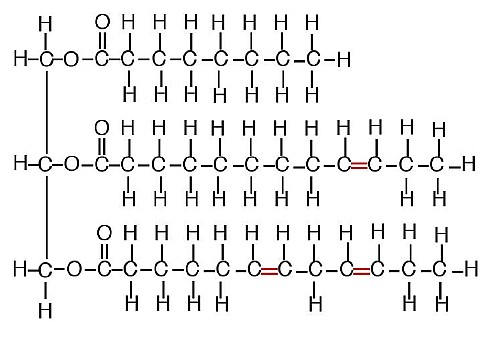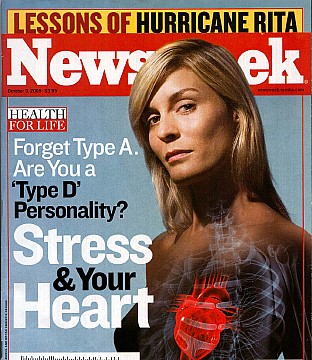 A TRIGLYCERIDE |
 GLUCOSE |
|
III
Lipoproteins
What 4 substances are in all 3 lipoproteins that we'll talk about? Watch the following Video Clip to answer this one. |
|
Now turn the page in your packet and go to page 74. Plants make triglycerides and phospholipids from fragments of glucose. Plants make sterols, but do NOT make cholesterol because they don't need cholesterol. They need sterols, just not cholesterol. Animals make triglycerides from fragments of carbohydrates, proteins or fats. Animals can make cholesterol from saturated fatty acids. Humans make all of the fatty acids they need except 2 called the EFA (essential fatty acids). Look at the following drawings and notice that both of them are combinations of carbon, hydrogen and oxygen atoms. As I said, both plants and animals (including us) can make fat (triglycerides) from fragments of glucose. |
 A TRIGLYCERIDE |
 GLUCOSE |
|
III
Lipoproteins
What 4 substances are in all 3 lipoproteins that we'll talk about? Watch the following Video Clip to answer this one. |
| Video
Clip: Lipoproteins approximately 6 minutes |
| If an approximately 6-minute movie isn't showing up just above on your computer, you may not have the latest version of QuickTime on your computer. Click here to download the newest version of Quick Time. |
|
IV Recommendations regarding lipids & heart health Key words include enjoy, whole and variety/balance.
Watch the next Video Clip to complete these blanks in your Lecture Outline. Nutritional disadvantages of a low fat diet.
|
| Video
Clip: Lipids and Heart Health approximately 5 minutes |
| If an
approximately 5-minute movie isn't showing up
just above on
your
computer, you may
not have the latest version of QuickTime on your computer. Click here
to download the newest version of Quick Time. Saturated fat in the diet usually has a bigger effect on someone's risk of heart disease than does the actual cholesterol in the diet. The saturated fat is used by the body to make cholesterol, which can collect along artery walls and obstruct blood flow. As your Lecture Outline says, cholesterol is a wax.  Something that can contribute to the obstruction is damage to the lining of the blood vessels, which can happen due to a variety of reasons, including smoking. When the lining of the heart artery is damaged, small blood particles called platelets accumulate causing reduced blood flow and a heart attack.  |
 |
The Harvard Mental Health Letter says that people with a set of traits known as the Type D (“distressed”) personality suffer from a high degree of emotional distress, but they consciously suppress their feelings. |
 |
| Video
Clip: A Little More About Risk of Heart Attacks approximately 1 minute |
| If an approximately 1-minute movie isn't showing up just above on your computer, you may not have the latest version of QuickTime on your computer. Click here to download the newest version of Quick Time. |